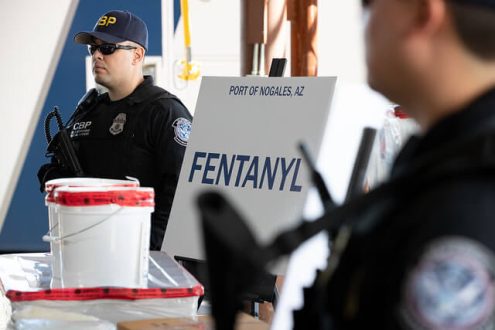The opioid crisis has forced U.S. law enforcement to confront new types of illicit actors, including fentanyl traffickers. The highest purity fentanyl is smuggled not by a cartel in the wheel wells of a produce truck, but via international mail. It ships mainly from China by small networks unaffiliated with a major drug trafficking organization. Unlike cocaine or heroin, fentanyl can be produced without the use of any plant matter, reducing the barriers to entry for traffickers.
Given these factors, analysts tracking fentanyl traffickers through open-source data must adopt additional investigative sources and methods. This post both explores how to apply established open-source research techniques to fentanyl traffickers and suggests several new strategies.
The examples used here are based on research into the network of Jian Zhang, a Chinese fentanyl trafficker sanctioned by the U.S. Department of the Treasury in April 2018. The sanctions included Zhang, his Hong Kong company Zaron Bio-Tech (Asia) Limited, and four other Chinese nationals acting on his behalf. U.S. prosecutors previously indicted Zhang and his co-conspirators in 2017.
Technique #1: Look at Fentanyl Traffickers’ Legal Entities—and Beyond
Many drug traffickers rely on companies owned by their family members or associates to facilitate business and launder money. These companies’ corporate filings, which often reveal key individuals and businesses linked to traffickers, can be highly useful to analysts.
Investigators can also apply this type of analysis to fentanyl traffickers. Using Sayari Search, we identified two U.S. limited liability companies operated by Jian Zhang’s indicted co-conspirators. We also identified five foreign companies owned or controlled by a former director of Zhang’s company, Zaron Bio-Tech.
However, analysts also may find compelling leads outside of official company registries. In 2016, indicted Zhang co-conspirator Darius Ghahary registered Etsy and Facebook profiles for a clothing brand called I Am Apparel. Given prosecutors’ references to digital currency payments in his indictment, these storefronts—which could in theory help process such transactions—seem especially relevant.
While “El Chapo” Guzmán probably wouldn’t make a Pinterest profile using his own email address, the lower profile of the individuals involved in the fentanyl business could make these types of haphazard oversights more likely. To account for this, analysts should leave no stone unturned, no matter the source website or database.
Technique #2: Follow the Digital Identifiers
Given how much of the fentanyl trade takes place through online transactions, analysts should devote as much time to identifying records with usernames and email addresses as they would identifying corporate records with the name of an individual or a company.
The Zhang indictment provides a list of usernames used by his drug trafficking network. By merely Googling these terms (enclosed in quotation marks to return exact matches), we found the following results tied directly to Zhang’s indicted co-conspirators:
- A Chinese message board post directly soliciting fentanyl offers;
- A public PGP key allowing users to send and receive encrypted messages;
- A Facebook profile directing associates to get in contact via an encryption application;
- The website for Dream Team Auto, one of the above-mentioned limited liability companies; and
- The Facebook page for I Am Apparel (see above).
Chasing these types of unofficial identifiers may seem unorthodox to analysts accustomed to relying on official documents. But the results uncovered all ultimately connect—directly or indirectly—to fentanyl purchasers and sellers. This suggests that examining these digital identifiers is worth the effort, despite the less clear-cut sourcing.
Technique #3: Look Out for Other Fentanyl Trafficking Networks Along the Way
Analysts investigating conventional drug cartels are not likely to stumble across conversation logs between drug suppliers and buyers. But by examining the wall posts of one Facebook profile (see above) used by Daniel Vivas Cerón, a co-conspirator of Jian Zhang who pleaded guilty to drug trafficking charges last week, we were able to identify another fentanyl trafficking network.
“Jackie,” an account communicating publicly with Vivas in 2015 over Facebook, operates multiple social media profiles selling “pharmaceutical intermediates.” The account also operates a website that, as of August 2018, sold methoxyacetyl fentanyl, a leading DEA-scheduled fentanyl analogue (see Fig. 1).
The profiles claim that Jackie is the former manager of a Chinese pharmaceutical company that is currently in liquidation. However, nobody under that name appears in the company’s corporate filings. This suggests that “Jackie” is likely either a pseudonym or an invented persona, like the Facebook profile through which she appears to have communicated with Vivas.
Unlike the core Zhang network, “Jackie” remains active. Her Twitter account was suspended, possibly due to activity like posting the below image of parcel deliveries to U.S. addresses (see Fig. 2). Her Facebook and VKontakte accounts were still operating at the time this post was written.
Fig. 1. As of August 2018, the related profile’s website offered the DEA-scheduled fentanyl analog methoxyacetyl fentanyl (MAF). The website has since been removed.
Fig. 2. Screenshot of an image posted by Jackie’s suspended Twitter account showing postal service deliveries to multiple U.S. states. According to the DEA’s 2018 National Drug Threat Assessment, fentanyl from China made up 97 percent of the fentanyl seized from postal/consignment deliveries that year.
Open Secrets
The low profile of fentanyl traffickers has weakened attempts by law enforcement to address the opioid crisis. However, these same factors mean it is also uniquely vulnerable to open-source research by analysts willing to dig through public and digital records with unusual structures, sourcing, and identifiers like the ones described here. This post presents just a few examples of the myriad ways in which open data can track and expose fentanyl traffickers, big or small.
The public records data used to power this research is available through Sayari Search! If you’re curious how this data could drive insights for your team, please reach out here.



